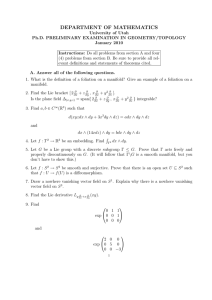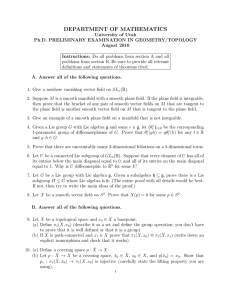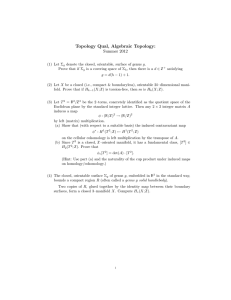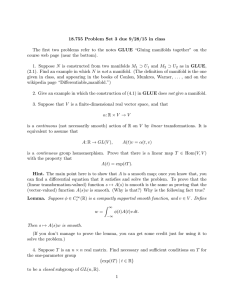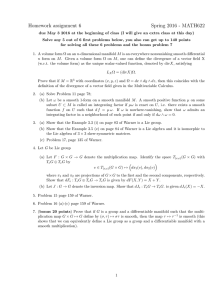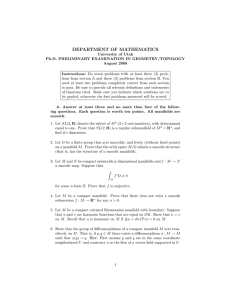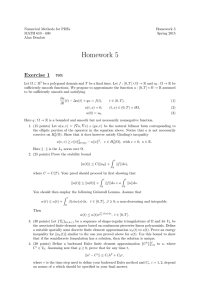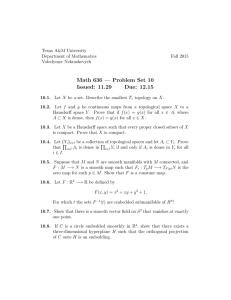DEPARTMENT OF MATHEMATICS
advertisement
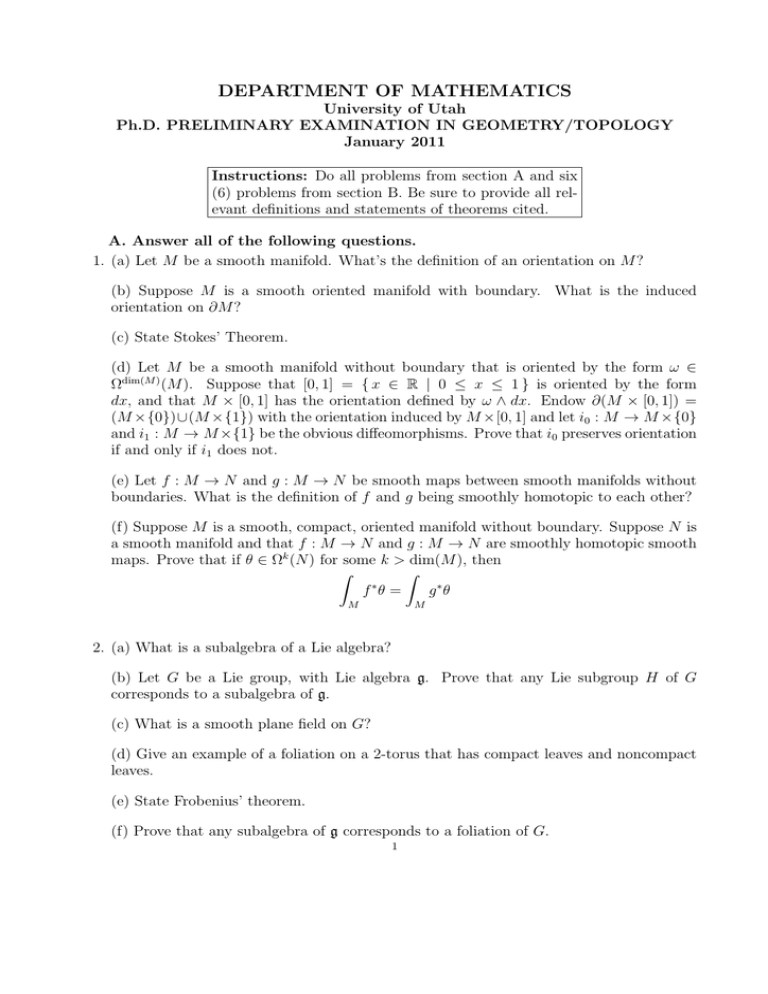
DEPARTMENT OF MATHEMATICS
University of Utah
Ph.D. PRELIMINARY EXAMINATION IN GEOMETRY/TOPOLOGY
January 2011
Instructions: Do all problems from section A and six
(6) problems from section B. Be sure to provide all relevant definitions and statements of theorems cited.
A. Answer all of the following questions.
1. (a) Let M be a smooth manifold. What’s the definition of an orientation on M ?
(b) Suppose M is a smooth oriented manifold with boundary. What is the induced
orientation on ∂M ?
(c) State Stokes’ Theorem.
(d) Let M be a smooth manifold without boundary that is oriented by the form ω ∈
Ωdim(M ) (M ). Suppose that [0, 1] = { x ∈ R | 0 ≤ x ≤ 1 } is oriented by the form
dx, and that M × [0, 1] has the orientation defined by ω ∧ dx. Endow ∂(M × [0, 1]) =
(M ×{0})∪(M ×{1}) with the orientation induced by M ×[0, 1] and let i0 : M → M ×{0}
and i1 : M → M ×{1} be the obvious diffeomorphisms. Prove that i0 preserves orientation
if and only if i1 does not.
(e) Let f : M → N and g : M → N be smooth maps between smooth manifolds without
boundaries. What is the definition of f and g being smoothly homotopic to each other?
(f) Suppose M is a smooth, compact, oriented manifold without boundary. Suppose N is
a smooth manifold and that f : M → N and g : M → N are smoothly homotopic smooth
maps. Prove that if θ ∈ Ωk (N ) for some k > dim(M ), then
!
!
∗
f θ=
g∗θ
M
M
2. (a) What is a subalgebra of a Lie algebra?
(b) Let G be a Lie group, with Lie algebra g. Prove that any Lie subgroup H of G
corresponds to a subalgebra of g.
(c) What is a smooth plane field on G?
(d) Give an example of a foliation on a 2-torus that has compact leaves and noncompact
leaves.
(e) State Frobenius’ theorem.
(f) Prove that any subalgebra of g corresponds to a foliation of G.
1
(g) Given a subalgebra of g, and the corresponding foliation of G, prove that the leaf containing the identity is a group, and thus that there is a correspondence between connected
Lie subgroups of G and subalgebras of g.
B. Answer six of the following questions.
3. Define a deformation retract. Construct a 2-dimensional cell complex that contains both
an annulus S 1 × I and a Möbius band as deformation retracts.
4. Let G be a Lie group and 1 ∈ G the identity element. Prove that π1 (G, 1) is an abelian
group.
5. Let f : S 1 → S 1 be given by f (z) = z 2 , where we regard S 1 as the unit circle in C. Find
a presentation of the fundamental group of the mapping torus
Mf = S 1 × I/(z, 1) ∼ (f (z), 0)
of f .
6. Suppose that X and Y are two connected manifolds or cell complexes homotopy equivalent
to each other. Prove that their universal covers X̃ and Ỹ are homotopy equivalent to each
other. Carefully state all theorems you are using.
7. An algebraic fact, often used in homology theory, is that a short exact sequence of chain
complexes induces a long exact sequence in homology. State this fact carefully and give
a definition of the “connecting homomorphism” (the one that lowers the degree of the
homology group).
8. Let X denote the solid torus S 1 × D2 . Using Mayer-Vietoris, compute the homology
groups of the double of X, obtained by taking two copies of X and gluing them along the
boundary via the identity map. Also compute Hi (X, ∂X).
9. Let X be a finite connected cell complex such that H 2 (X; Z) = Z/2Z and H i (X; Z) = 0
for i = 1 and i > 2. Compute Hi (X; Z) for all i. State all theorems you are using.
10. Let M be a closed orientable connected 4-manifold with H 1 (M ) = H 3 (M ) = 0 and
H 2 (M ) = H 4 (M ) = Z. What are the possible cup product structures on H ∗ (M )? State
all theorems you are using. All cohomology groups are with integral coefficients.
2
